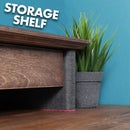Introduction: Turn Worktop Off Cuts Into Cutting Boards!
Had a new kitchen worktop installed? Got some off cuts from your kitchen remodel? Why not turn them into cutting boards and serving boards? Here's how...
Supplies
Step 1: Glue Up the Boards
These are the couple of cuts I'll be using to make a cutting board and a serving board. These are from a 42mm thick Oak kitchen worktop. As you can see, the one piece is pretty warped. The way we I cut this later will sort that out though.
The longer piece is best suited to being a cutting board as it has the grain running length ways and its nice and flat. I cut 2 pieces from it at the mitre saw. I went with 40cm in length but work with the material you have and cut them to a size that suits your needs.
I used a hand plane to flatten the sides that will be glued together. This creates a nice strong glue joint. The 2 pieces get clamped together. This gives me a board that's roughly 40cm x 25cm.
While the glue dries on the cutting board I could turn my attention to the warped board. I took it to the bandsaw and cut it into chunks. The size of chuncks aren't crucial but I kept them quite small so I could eliminate the warp that was in the board. It will also allow me to change the grain direction to run the length of the board rather than running the width as it does now.
The pieces are pretty chunky for a serving board so I used the bandsaw to resaw them in half. As you can see the grain orientation looks a lot better running in this direction. The trouble is, end grain joints aren't very strong when glued so I staggered the pieces into a brick wall pattern. This will make sure there is a long grain glue joint across where end grain meets. The pieces get glued and clamped together then left to dry.
Step 2: Cut to Size & Shaping
Once both boards were dry I could cut them to size at the bandsaw. I kept the cutting boards simple with straight edges.
I wanted the serving board to look more natural so I drew on some rough curves. With my larger blade still installed in my bandsaw I cut out the the curves. Because the blade is wide it resists cutting curves which has a great effect of making the curves more subtle and natural looking.
To finish off the shaping I took the board to the belt sander and smoothed all the curves and edges. I also sanded in a groove for a thumb hold and made that corner slightly thinner so it would be easier to pick up.
Step 3: Add Hand Holds to Cutting Board
I thought the cutting board could do with some hand holds so using a cove bit in the router and a straight edge clamped to it I carved 1 hand hold in the centre of the 2 shorter sides.
Last thing that I did to the cutting board was to ease over all the edges with a chamfer bit in the router.
Step 4: Apply the Finish
For the finish I used butcher block oil. This is a food safe finish. I gave them 3 coats of oil. They need to be regularly topped up with more oil too.
Step 5: Done!
Here are the finished boards. I hope you like them! Definitely give it a go if you have some kitchen worktop off cuts!













